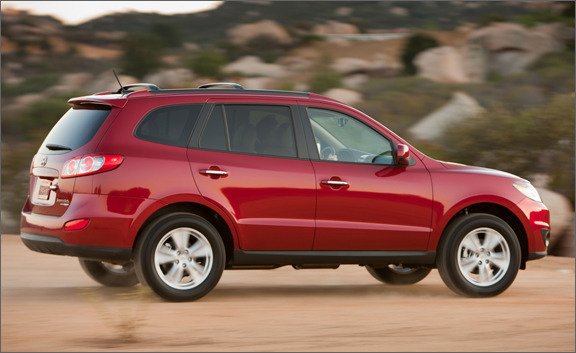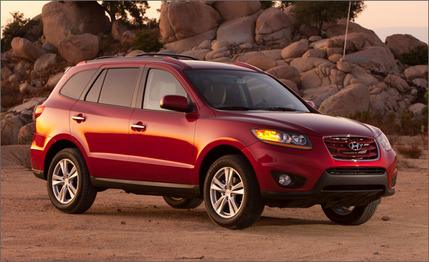 Short Take Road Test
Short Take Road Test
Hyundai’s entry in the super-competitive mid-size-crossover segment got a refresh for 2010, the focus being its underpowered engine lineup. The base 185-hp, 2.7-liter V-6 was replaced by a more-fuel-efficient 2.4-liter four making 175 hp, and the uplevel Lambda V-6 was extensively upgraded and grows from 3.3 liters to 3.5. Output increased from 242 hp to 276. Front-wheel-drive, four-cylinder models have a six-speed manual as standard—a six-speed auto is optional. V-6s and all-wheel-drive examples only offer the self-shifting tranny. (Previously, the Santa Fe offered a five-speed stick and four- and five-speed automatics.)
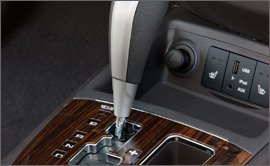
Hyundai didn’t do much to call attention to the changes. It just slapped on a new grille, new front and rear fascias, and fresh taillights. New backlit gauges, Bluetooth hands-free connectivity, and steering-wheel-mounted audio controls are standard; a touchscreen navigation system and a backup camera are available. The company dropped the optional third-row seat, leaving the larger Veracruz to take care of serial breeders.
Similar Feel, Speedier Acceleration
With no changes to the suspension, the updated model drives like the old version, except in the way it gets away from stoplights. In a 2008 comparison test, the most powerful Santa Fe at the time needed 8.4 seconds to get to 60 mph and plodded through the quarter-mile in 16.5 seconds at 86 mph. The hotter V-6 in the revised trucklet addresses that problem, chopping 1.3 seconds from the 0-to-60 time—doing the deed in 7.1—and scooting through the quarter in 15.4 with a trap speed of 91 mph. Passing performance is better, too, with the 50-to-70-mph test taking 5.1 seconds instead of 5.8.
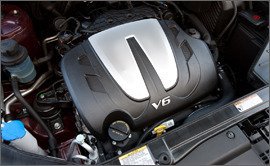
On the skidpad, the 2010 Santa Fe pulled 0.77 g and stopped from 70 mph in 186 feet, figures about average for the class. The EPA fuel economy is improved, with predicted figures of 20 mpg in the city and 26 mpg on the highway, up from 17/23 for the old vehicle. Our test drivers, all seemingly born with heavy right feet, managed just 19 mpg.
The new powertrain hasn’t addressed our biggest complaint from that ’08 comparo, however, which is the Santa Fe’s fun-free on-road demeanor. We don’t suggest that crossovers hunker down into curves like a Corvette, but a Mazda CX-7 or a Nissan Murano feels light on its feet and engages with its driver. The Santa Fe doesn’t really care to get into a conversation. The steering is vague off-center, the ride gets a touch discombobulated over bumpy pavement, and the brake pedal feels mushy. At least the Hyundai keeps body roll reasonably well checked. The engine is sweet until the tach needle gets close to the danger zone, at which point it’s raucous in a way that V-6s from the competition aren’t. The six-speed shifts sweetly, but the vehicle’s dry personality won’t have you flirting with its manumatic function.
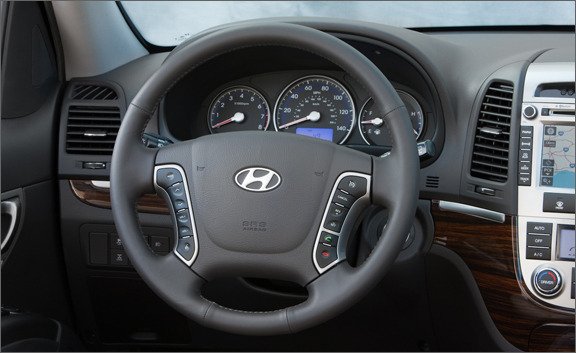
Bland Fish in a Big Pond
To be fair, nothing in this class is truly great to drive, and the Santa Fe delivers in the areas more important to shoppers. It gets high marks for its excellent interior fit and finish, with lots of soft-touch pieces and comfy leather seats. The new gauges are classy, and the touch-screen nav system works intuitively. Interior space is competitive with that of other two-row SUVs, and the Santa Fe has more cargo space than do most of its rivals.
It also scores points based on value. Our top-of-the-line, all-wheel-drive Limited model came in at $33,465, complete with leather seats, a power driver’s seat, automatic climate control, a power sunroof, and a touchscreen navigation system. A comparably equipped Chevy Equinox costs a few grand more and doesn’t feel as nice inside, and the similar Ford Edge Limited, although admittedly offering a bit more stuff, comes awfully close to the 40-grand mark.
Perhaps the Santa Fe’s most compelling rival, however, comes from within the family: the Kia Sorento. The Sorento is better to drive than the Santa Fe and looks more European, whereas the Hyundai’s is a generic Asian design. The Santa Fe is a good value in this segment and doesn’t do anything badly. The problem is that its competition is better.
